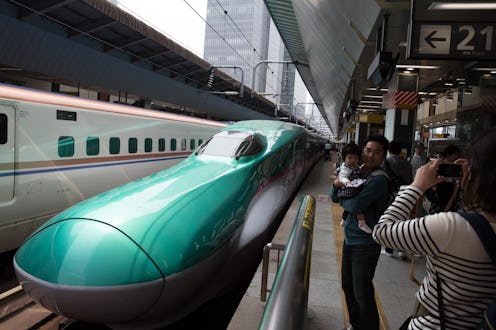One of the staples of the New York City subway system has long been its iconic MetroCard ... but no more! The Metropolitan Transit Authority announced this week that it plans to phase out the Metrocard by 2019. Replacing the iconic yellow-and-blue card, which turned 20 years old this week, will be an app-based "fare payment technology" — similar to Washington, D.C.'s SmarTrip cards.
No specific plans are in place yet, but the MTA tells Fast Company that ticket dispensing machines are increasingly outdated and expensive to maintain, and travelers could instead use credit cards or smartphones to gain entry. Tapping, it seems, could replace swiping. (At least that means no more fumbling around the bottom of your bag.)
Tokens were replaced by cards in 1994 on the NYC subway system, which serves around 1.6 billion people a year. Astonishingly, the New York City subway provides service for a massive one-third of all public transit riders in the United States. As the subway starts to modernize yet again, let's take a look at other public transit systems around the world that completely warp the experience of getting around town...
Brighton's Big Lemon Bus
In the English seaside town of Brighton, a bright yellow fleet of Big Lemon buses are a familiar sight. The buses use recycled cooking oil — largely chip fat (or fries, for Americans) from the many fish-and-chip shops in the city. The video looks at the process of turning cooking waste into biofuel — note the students clutching onto lemons for dear life, lest they have to pay money.
Plus, with the U.S. Navy embracing used cooking oil with their Green Fleet, biofuel has the potential to become much more widely used.
Hyper Over the Hyperloop
Never one for tradition, Elon Musk, the founder of Tesla Motors, introduced his idea of a new mode of transportation in 2013: the "hyperloop." Promising to take you from San Francisco to Los Angeles in a mere half an hour, at a speed of around 800mph, Musk considers this a "fifth mode" of transportation, in addition to planes, trains, automobiles, and boats.
While speculation is rampant because Musk has left out crucial details like how exactly it will work, Musk said it's "a cross between a Concorde, a rail gun, and an air hockey table." It's also likely, according to Internet theorists, that it will involve Maglev technology. Don't hold your breath...
Japan's Bullet Trains
Across Japan, a series of high-speed "bullet trains," also known as shinkansen, connect the country and are widely regarded as one of the best rail system in the world. The first line opened in 1964 and can reach top speeds of 186mph, or 300km/h — the average speed of a train is roughly 90 km/h, to put that in perspective.
The success of these "bullet trains" have led to many U.S. states vying for their own version to improve existing transit. In California, a proposed plan for a bullet train spanning the whole state remains a divided issue. And in Texas, a 205mph train connecting Houston and Dallas is being touted as a future possibility.
The Shweeb
Not only does the Shweeb have the best name of any transport system on this planet, it looks like a lot of fun. Based in New Zealand, the Shweeb is a monorail system in which travelers enter individual pods and cycle along the track.
Perhaps best for left for warmer locations, the outdoorsy Schweeb doesn't exactly look Polar Vortex friendly. Still, we'd take this over a cramped L train any day.
Washington's Revamped Streetcars
Streetcars haven't been seen on the streets of D.C. since 1962, but December 2013 marked their reintroduction to Washington, D.C.
The modern trams mirror the red-and-yellow sloped design of the city's buses, and the first car was delivered to the H St. NE corridor at the end of last year. Eventually, 37 miles of streetcar tracks will span across the city.
But even though there's change on the horizon, you can guarantee that New Yorkers will still be leaving all sorts of weird, wonderful, and pretty essential things in the Subway. False teeth and a dead shark, anyone?
Image: Getty
